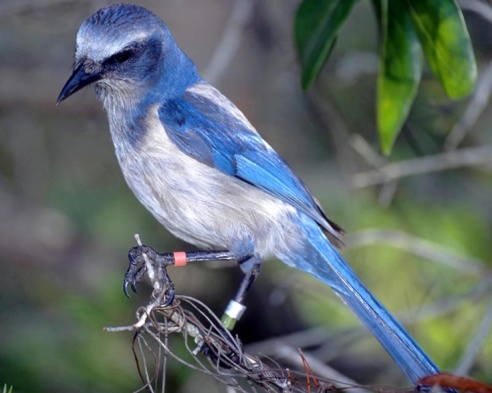
While the Decennial U.S. Census figures are based on actual counts of persons dwelling in U.S. residential structures, the Indian River County Conservation Lands Program conducts their own census on actual counts of Florida Scrub Jays dwelling in their own residential territories.
Dr. Ron S. Jarmin is performing the non-exclusive functions and duties of the Director of the U.S. Census Bureau. Beth Powell, Indian River County Conservation (IRC) Lands Manager, oversees IRC’s Florida Scrub Jay census.
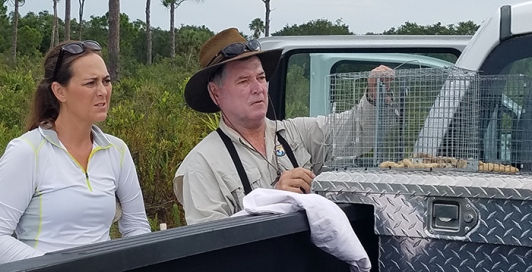
Beth Powell overseeing the IRC census.
The Florida Scrub Jay is perhaps one of the most studied of all birds. The Archbold Biological Station, a 5,192-acre research institute near Lake Placid, FL has been studying the Florida Scrub Jay for more than 35 years.
Protected under the Endangered Species Act, Florida Scrub Jays are only species of bird endemic to the U.S. state of Florida and one of only 15 species endemic to the continental United States. While the range of this bird once included almost all of Florida, it is now limited to just six counties.
Florida Scrub Jays are not recorded anywhere else on earth.
Florida Scrub Jays are one of the few “cooperative” breeding birds in North America. Fledglings typically stay with their parents where they hatched as “helpers”, forming cooperative family groups, helping raise the following year’s young before leaving their family to form their own territory.
Within each family group one individual acts as a sentinel, looking out for predators. Females bob up and down and point their bill upward when they detect an intruder.
Scrub Jays mate for life, although a “divorce” has been recorded in some instances. They can live 10-15 years, typically not travelling more than a few miles from where they are born. Families can range in size from 2 to 8. Mr. and Mrs. Scrub Jay build a new nest each year between February and March. The nest is made from oak twigs and palm fibers, and is normally located in a low, dense shrub around one meter off the ground.
Since the Scrub Jays do not travel far from where they were born, they can be uniquely identified in the field by “banding”. This the practice of catching the birds, marking them with an identifying band around the legs, and then releasing them.
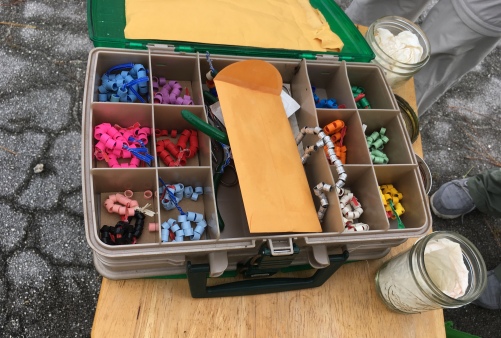
Identification of individual jays by banding in the Sebastian area helps biologists determine how the species is doing over time. Tracking a banded jay can reveal how far they have traveled, what territory they are occupying, how many juveniles they have produced and with which other jay they have mated.
The way they are caught to be banded are cage traps to bait the birds. The door cages are triggered to shut when a bird enters. Then the birds are removed from the traps, placed individually in protective covers and taken to the banding station where each bird is banded and later released in the same area where they were trapped.
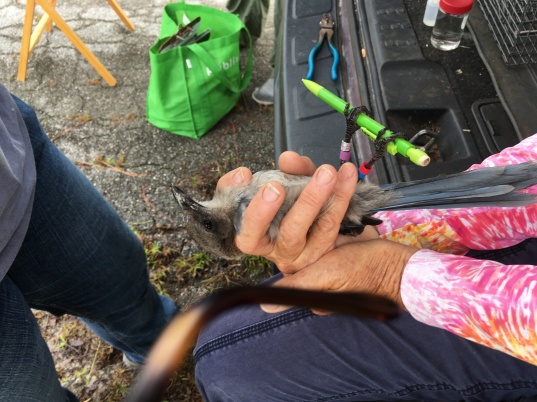
“There is a strict protocol in place to ensure the health and safety of the birds during banding,” said Kevin Palmer, a biologist with the US Fish & Wildlife Service. “At the banding station, we carefully restrain their wings and provide a pencil, which they instinctively grasp onto, which helped hold their legs steady. It is much like how they perch. It has a calming effect on them.”
Each bird is banded and released within 10 minutes after being captured.
With able assistance from volunteers and a licensed bander (contractor) and several of their biologists, the Indian River County Conservation Lands Program banded 39 Florida Scrub Jays in July 2017, the most ever in one week. In July 2018, 20 Scrub Jays were banded.
“Right now, we’ve got 125 total birds banded. That’s 95 percent of the estimated bird population we monitor,” said Ms. Powell. “We know our Scrub Jay families so well they have names.”
The Florida Scrub Jay feeds on plants and animals, consuming everything from acorns and berries, through to snakes, frogs and young birds; with a variety of insects and spiders.
With such a diverse range of food items the Scrub Jays have a number of different foraging techniques; including picking insects off plants, hoarding acorns in the ground, scaring prey out of vegetation.
Scrub Jays routinely hoard and cache thousands of acorns a year, burying them just beneath the surface. The acorns are typically buried in the fall and consumed during the winter and spring. Acorns that are forgotten or missed may geminate, making the Florida Scrub Jay an effective agent for the dispersal of a variety of oak trees.
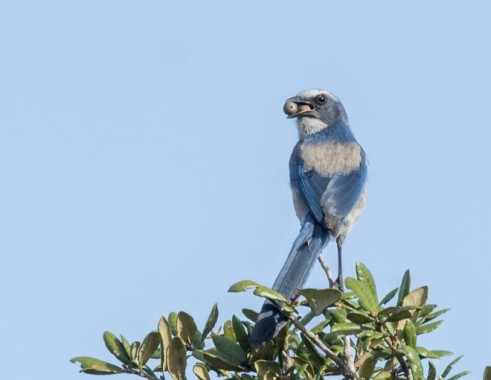
They hold acorns in their feet, hammering them apart with their chisel-like bill. When they’ve had enough to eat, they hammer them into the sandy soil or stuff them into palm fronds or moss to eat later in the year. They often place a leaf or twig over the area to help them remember where they buried it. Throughout the year, they also dig up and recache the acorns perhaps to check on the condition of the acorn or to help them remember the location. A single Florida Scrub Jay may cache between 6,500 and 8,000 acorns each fall.
Acorns that are forgotten or missed may geminate, making the Florida Scrub-Jay an effective agent for the dispersal of a variety of oak trees.
The Scrub Jays species is restricted to low-growing (less than 6.5 feet tall) oak scrub habitat on sandy soil. Within these patches of oak scrub, they frequent relatively open areas and bare sandy patches. The Florida scrub-jay is an all-year resident, not a snow bird.
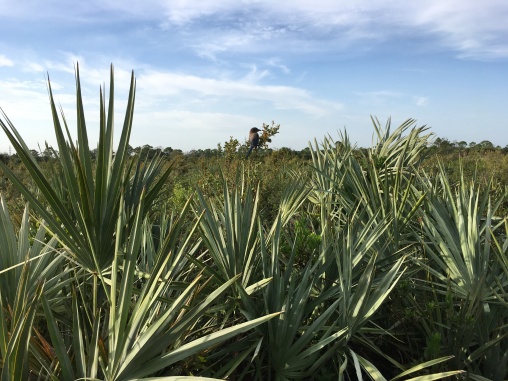
Florida Scrub Jay in its habitat.
Males and females Scrub Jays are not visually distinguishable, but females have a unique “hiccup” vocalization.
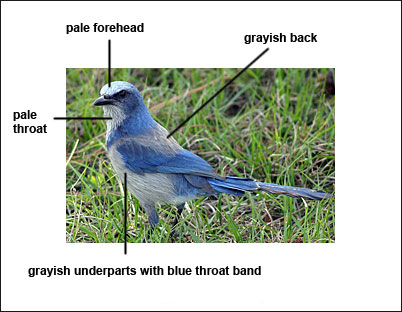
Florida Scrub Jays are crestless jays with gray upperparts and underparts, a blue head, and pale eyebrows. Their throat is gray and breasts have blue-gray streaks. The wings and tail are blue, while their bill, legs and feet are black.
They hop around on the ground navigating around oak scrub and are hesitant to fly across non-oak-scrub habitat.
During courtship, the male hops in a circle around a female with his fanned tail tipped toward her and dragging on the ground. He also fans out the feathers around the “ear” and eyebrow and sometimes gently pecks at her feet.
Unfortunately, the Florida Scrub Jay is a declining species with an estimated population of 4,000 individuals according to Partners in Flight.
The largest scrub habitat in Indian River County is the St. Sebastian River Preserve State Park with 21,748.42 acres (33 square miles), which is shared with Brevard County. This park is home to the fourth largest Scrub Jay population in Florida.
One of the goals of the Sebastian Area Florida Scrub Jay Conservation Plan is to bring juveniles from St. Sebastian River Preserve State Park to other conservation areas. So far IRC biologists have documented more than 10 successful dispersals with more dispersing each year. This helps to provide genetic resilience to the population within the State Park, protecting their population from catastrophic events.
Beth Powell is seeking volunteers to assist with the monitoring of Florida Scrub Jays on conservation lands and surrounding areas. If you are a birder this is for you. Volunteers will assist the county in monitoring assigned areas and families of Scrub Jays. These tasks require training and performance under a federal permit. Volunteers must be able to work year-round and especially in the months of June-August. Ability to work in outdoor elements, during high temperatures and without shade is necessary.
Our sense is that Scrub Jays are like people but they don’t talk.
If you are interested in volunteering please contact Beth Powell at either bpowell@ircgov.com or 772-226-1873.
Harassing or harming a Scrub-Jay is a federal offense. Disturbing a nest is also illegal.
Florida Scrub Jays are very friendly. Please do not feed them.
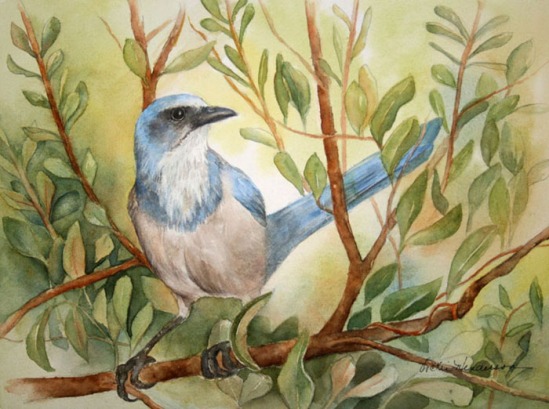
vickiehenderson.com
Sources:
https://www.arkive.org/florida-scrub-jay/aphelocoma-coerulescens/
http://www.ircgov.com/Departments/General_Services/Parks/Conservation/Scrubjays.htm
https://www.allaboutbirds.org/guide/Florida_Scrub-Jay/lifehistory
http://pif.birdconservancy.org/ACAD/Database.aspx
https://www.arkive.org/florida-scrub-jay/aphelocoma-coerulescens/
https://identify.whatbird.com/obj/788/_/Florida_Scrub-Jay.aspx
The President’s Hoot by
Richard H. Baker, Ph.D.
Thanks for running this article. Not enough people know about our local birds
LikeLike